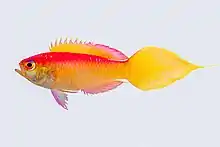| Callanthiidae | |
|---|---|
 | |
| Grammatonotus brianne | |
| Scientific classification | |
| Domain: | Eukaryota |
| Kingdom: | Animalia |
| Phylum: | Chordata |
| Class: | Actinopterygii |
| Order: | Spariformes |
| Family: | Callanthiidae Fowler, 1907 |
| Genera | |
|
See text | |
Callanthiidae, the splendid perches and groppos is a small family of marine ray-finned fishes in the order Spariformes. These fishes are mainly found in the Indo-Pacific but two species are found in the eastern Atlantic and Mediterranean.
Taxonomy
Callanthiidae was first proposed as a family name in 1907 by the American zoologist Henry Weed Fowler.[1] This family was classified in the order Perciformes but the 5th edition of Fishes of the World classifies w=the family within the order Spariformes, although states that there is some doubt about the family's exact classification.[2] Other workers have classified the family as incertae sedis within the series Eupercaria.[3]
Etymology
Callianthiidae, takes its name from Callianthias its type genus. Callianthias is a combination of callos, meaning "beautiful", and Anthias the genus in the family Serranidae. Lowe named the genus this because he described its type species, Callanthias paradisaeus, as "a most elegant little fish" and "almost as rare as beautiful" and noted the resemblance on form and dentition to Anthias.[4]
Genera
Callanthiidae is divided into two genera:[5][6]
- Callanthias Lowe, 1839
- Grammatonotus Gilbert, 1905
Characteristics
The Callanthiidae are characterised by a flat nasal organ, lacking any lamellae. The lateral line runs along the base of the dorsal fin and ends close to the end of that fin or it extends on to the caudal peduncle. The dorsal fin is supported by 11 spines and between 9 and 11 soft rays. There is a midlateral row of modified scales with a series of pits and sometimes grooves. These splendidly coloured fish[2] have a maximum total length of 30 cm (12 in), the largest species being the splendid sea perch (Callianthias allporti).[5]
Distribution
The Callanthiidae are mostly found in the Indo-Pacific region as far east as Hawaii. Two species are found in the eastern Atlantic and Mediterranean.[5]
References
- ↑ Richard van der Laan; William N. Eschmeyer & Ronald Fricke (2014). "Family-group names of recent fishes". Zootaxa. 3882 (2): 1–230. doi:10.11646/zootaxa.3882.1.1. PMID 25543675.
- 1 2 Nelson, J.S.; Grande, T.C.; Wilson, M.V.H. (2016). Fishes of the World (5th ed.). Hoboken, NJ: John Wiley & Sons. pp. 502–506. doi:10.1002/9781119174844. ISBN 978-1-118-34233-6. LCCN 2015037522. OCLC 951899884. OL 25909650M.
- ↑ Ricardo Betancur-R; Edward O. Wiley; Gloria Arratia; et al. (2017). "Phylogenetic classification of bony fishes". BMC Evolutionary Biology. 17 (162). doi:10.1186/s12862-017-0958-3. PMC 5501477.
- ↑ "Series EUPERCARIA (Incertae sedis): Families CALLANTHIIDAE, CENTROGENYIDAE, DINOPERCIDAE, EMMELICHTHYIDAE, MALACANTHIDAE, MONODACTYLIDAE, MORONIDAE, PARASCORPIDIDAE, SCIAENIDAE and SILLAGINIDAE". The ETYFish Project Fish Name Etymology Database. Christopher Scharpf. 9 March 2023. Retrieved 14 October 2023.
- 1 2 3 Froese, Rainer, and Daniel Pauly, eds. (2023). "Callanthiidae" in FishBase. June 2023 version.
- ↑ Eschmeyer, William N.; Fricke, Ron & van der Laan, Richard (eds.). "Genera in the family Callanthiidae". Catalog of Fishes. California Academy of Sciences. Retrieved 14 October 2023.